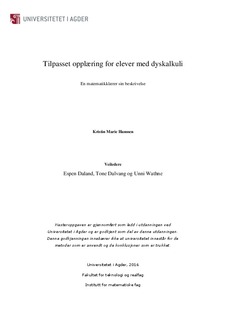Tilpasset opplæring for elever med dyskalkuli : en matematikklærer sin beskrivelse
Master thesis
Permanent lenke
http://hdl.handle.net/11250/2412264Utgivelsesdato
2016Metadata
Vis full innførselSamlinger
Sammendrag
The main topic of the thesis is how to adapt teaching to students with dyscalculia. In this thesis, the term dyscalculia is accounted for as one of several concepts for students who struggle particularly with mathematics. There is currently a lack of consensus among scientists about which concepts to be used for students with mathematics difficulties and what is meant by the different terms. In the thesis, there is therefore a separate chapter which presents an overview of the literatures use of concepts for students who have learning difficulties in mathematics. The thesis research questions consist of a main question and two sub-questions. Research question:
- What arguments does a mathematics teacher give on how lessons are adapted for students with dyscalculia?
Underresearch questions:
- What does the maths teacher do to adapt teaching for students with dyscalculia?
- What are the implications in mathematics teaching when teaching is adapted for students with dyscalculia?
The method the research is based on is a qualitative case study of a teacher. Adaptation of the mathematics teaching for students with dyscalculia is the case study. I collect data through a semi-structured interview of a teacher, thus the teacher is the evaluation unit. The teacher being interviewed has worked as a high school teacher for several years and has had several students with dyscalculia.
The research findings will be presented through the factor interaction model, Magne (1998). This model consists of three dimensions. The dimensions are about the pupils' learning style, the mathematics academic content and the social interaction. The model's different dimensions are interrelated and this correlation is reflected in the case studies findings.
The research has four main findings from the main research question. One of the reasons the teacher has for how the teaching is adapted, is that no pupils are similar. Another finding is that students with mathematics difficulties show a lack of knowledge in mathematics. A third reason for the choice of personalized teaching is based on the pupils need to experience motivation, mastery and understanding of mathematics. A fourth finding is that students with dyscalculia need extra time and repetition.
There are various ways a teacher can work in order to adapt the teaching of mathematics. There is no blueprint for how this adaptation should be done. The teacher in this case study varies between allowing pupils to do similar tasks and providing students with customized tasks. The teacher adapts his lessons by explaining the subject matter in different ways and allows students to collaborate. The teacher varies the teaching and varies the tasks he gives the students. Self-assessment is a working method the teacher uses to adapt his teaching. Other ways to adapt the teaching is to have two teachers present in the classroom, and that some students who are struggling are not dealing with parts of the curriculum.
How tuition is adapted will give different consequences. In this case study a result of the teacher's adaptation is that the teacher talks with the pupil. The students get the opportunity to gain an active role and participate in the class community. Teachers need adequate expertise, so that the learning material will cover the individual student's academic level. Students at various academic levels are given the opportunity to explain math to one another through cooperation with each other. Through facilitation the students' different needs for different explanation ways are covered.
Beskrivelse
Masteroppgave matematikkdidaktikk – Universitetet i Agder 2016
